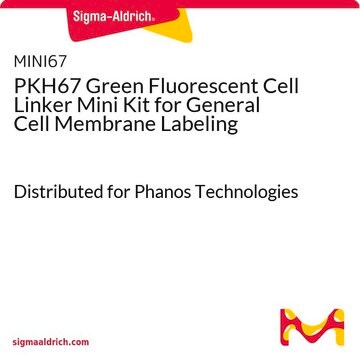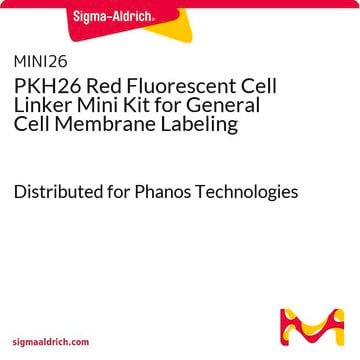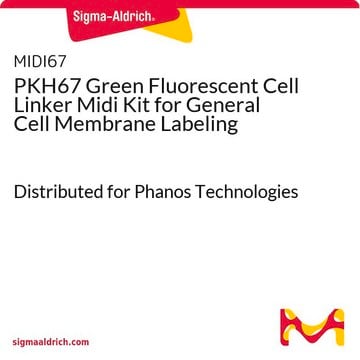Yes, Product PKH67 would be suitable for this application. In this paper, both Products PKH26 and PKH67 are used in a similar application:
https://www.ncbi.nlm.nih.gov/pmc/articles/PMC5679712/
PKH67GL
Kit de lieur cellulaire à fluorescence verte au PKH67 pour le marquage des membranes cellulaires à usage général
Distributed for Phanos Technologies
Synonyme(s) :
Green PKH membrane labeling kit
About This Item
Produits recommandés
Niveau de qualité
Conditionnement
pkg of 1 kit
Conditions de stockage
protect from light
Fluorescence
λex 490 nm; λem 502 nm (PKH67 dye)
Méthode de détection
fluorometric
Conditions d'expédition
ambient
Température de stockage
room temp
Application
Une perte lente de fluorescence a été observée dans des études in vivo utilisant le PKH1 et le PKH2. Le PKH67 peut présenter des propriétés similaires puisque ce comportement semble être caractéristique des colorants de liaison des cellules vertes, mais pas des colorants de liaison des cellules rouges. La corrélation entre la rétention in vitro de la membrane cellulaire et la demi-vie de fluorescence in vivo dans des cellules non en division permet de prévoir une demi-vie de fluorescence in vivo de 10-12 jours pour la PKH67. D'autres colorants verts de liaison cellulaire ayant une demi-vie similaire ont été utilisés pour suivre le trafic des lymphocytes et des macrophages in vivo sur des périodes de 1 à 2 mois, ce qui suggère que le PKH67 sera également utile pour des études de suivi in vivo de durée moyenne.
- marquage et analyse des exosomes expulsés par les cellules dans le cancer du sein triple négatif[1]
- marquage des cellules apoptotiques[2] afin d'étudier le rôle joué par le récepteur de l'ανβ5 dans la liaison et l'internalisation des cellules apoptotiques[3]
- imagerie en fluorescence[4]
Liaison
Informations légales
Composants de kit seuls
- Diluent C 6 x 10
- PKH67 Cell Linker in ethanol .5 mL
Produit(s) apparenté(s)
Mention d'avertissement
Danger
Mentions de danger
Conseils de prudence
Classification des risques
Eye Irrit. 2 - Flam. Liq. 2
Code de la classe de stockage
3 - Flammable liquids
Point d'éclair (°F)
57.2 °F - closed cup
Point d'éclair (°C)
14 °C - closed cup
Faites votre choix parmi les versions les plus récentes :
Déjà en possession de ce produit ?
Retrouvez la documentation relative aux produits que vous avez récemment achetés dans la Bibliothèque de documents.
Les clients ont également consulté
Articles
PKH dyes are easy to use and achieve stable, uniform, and reproducible fluorescent labeling of live cells. PKH dyes are non-toxic membrane stains which produce high signal to noise ratio.
PKH dyes are easy to use and achieve stable, uniform, and reproducible fluorescent labeling of live cells. PKH dyes are non-toxic membrane stains which produce high signal to noise ratio.
PKH dyes are easy to use and achieve stable, uniform, and reproducible fluorescent labeling of live cells. PKH dyes are non-toxic membrane stains which produce high signal to noise ratio.
PKH dyes are easy to use and achieve stable, uniform, and reproducible fluorescent labeling of live cells. PKH dyes are non-toxic membrane stains which produce high signal to noise ratio.
-
I mark mitochondria for injection with PKH26 Red Fluorescent Cell Linker Kit for General Cell Membrane Labeling. I want to use another dye to mark another type of mitochondria and inject them together in the same fish egg. Is PKH67 ok for this like PKH26?
1 answer-
Helpful?
-
-
What can be the alternative for removing excess dye after labeling of exosomes using PKH67 dye apart from ultracentrifugation?
1 answer-
Excess dye is bound to serum or albumin which is added to the cell/dye mixture as a stop reaction. The recommended clean up or dye removal is by standard centrifugation (400 x g for 10 minutes, wash, and repeat). See the Product Information Sheet, page 3, bullet point 8 for more information:
https://www.sigmaaldrich.com/deepweb/assets/sigmaaldrich/product/documents/984/984/pkh67glbul.pdfAlternate methods for excess dye removal have not been investigated.
Helpful?
-
-
Can we remove the excess PKH67 DYE used for the labeling of exosomes using exosome spin column rather than ultracentrifugation.
1 answer-
The recommended exosome labeling protocol has been optimized to assure the best possible results. The use of exosome spin columns with the PKH and CellVue products has not been validated. See below for a link to our exosome labeling protocol. A spin column method may not offer the best results.
Helpful?
-
-
Will Product PKH67, Green Fluorescent Cell Linker Kit, stain dead cells?
1 answer-
As long as the cell has an intact membrane, the PKH76 dye can label the cell.
Helpful?
-
-
What is the difference between Green Fluorescent Cell Linker Kits PKH2 and PKH67?
1 answer-
PKH2 was one of the early PKH dyes. The PKH67 dye has a longer aliphatic tail. There is reduced cell-celldye transfer for PKH67 as compared with PKH2.
Helpful?
-
-
What method of fixation can be used for tissue/cells with the PKH Fluorescent Cell Linker Kit for General Cell Membrane Labeling dyes?
1 answer-
A protocol for visualization of tissue sections can be found in the technical bulletin. For visualization of stained cells by immunofluorescence or flow cytometry, the cells can be fixed in 2% paraformaldehyde for 15 minutes. The use of other organic solvents will extract the dye from the cells. If internal labeling is desired, the cells can be permeabilized with saponin (50-75 μg/mL). Here is the link to the Troubleshooting Guide.
Helpful?
-
-
What is the Department of Transportation shipping information for this product?
1 answer-
Transportation information can be found in Section 14 of the product's (M)SDS.To access the shipping information for this material, use the link on the product detail page for the product.
Helpful?
-
-
What is the excitation and emission spectra for Product PKH67GL, Green Fluorescent Cell Linker Kit?
1 answer-
The spectra can be found on the product insert.The product has a maximum excitation at 490 nm and maximum emission at 502 nm.
Helpful?
-
-
How many cells can be stained with Product PKH67GL, Green Fluorescent Cell Linker Kit?
1 answer-
This kit can stain 50 × 107 cells if used as directed (1 × 107 cells stained with 2 × 10-6 M PKH67).
Helpful?
-
-
When using Product PKH67GL, PKH67 Green Fluorescent Cell Linker Kit for General Cell Membrane Labeling, how long will the cells remain stained after treatment?
1 answer-
Labeled cells that have been washed can be visualized in culture up to 100 days after staining (for non-dividing cells). The dye itself is stable and will divide equally when the cells divide. After staining with PKH dyes, you can observe as many as 8 divisions depending on how brightly the cells were stained initially and the amount of surface area on the cells. Most commonly, 4-6 divisions can be visualized.
Helpful?
-
Active Filters
Notre équipe de scientifiques dispose d'une expérience dans tous les secteurs de la recherche, notamment en sciences de la vie, science des matériaux, synthèse chimique, chromatographie, analyse et dans de nombreux autres domaines..
Contacter notre Service technique














